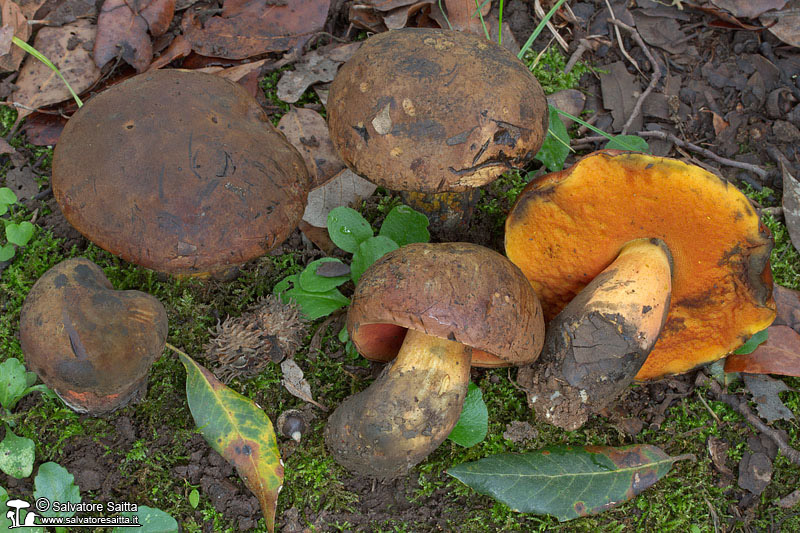NEOBOLETUS XANTHOPUS (Klofac & A. Urb.) Klofac & A. Urb.
Nome corrente: Neoboletus xanthopus (Klofac & A. Urb.) Klofac & A. Urb.
|
Intorno a quello che veniva chiamato Boletus erythropus s.l. gravitano adesso due differenti specie: Neoboletus xanthopus (Klofac & A. Urb.) Klofac & A. Urb. e
Neoboletus praestigiator (R. Schulz) Svetasheva, Gelardi, Simonini & Vizzini (il vero B. erythropus s. Fries 1860). Le due specie possono essere distinte con certezza solo tramite analisi del DNA, visto che non
esistono in pratica differenze microscopiche e l'aspetto macroscopico, variabile, può portare a sovrapposizioni. In generale N. xanthopus possiede puntini molto piccoli che fanno apparire
il gambo come liscio, è una specie
termofila e cresce sotto querce. Sono in corso ulteriori studi. Neoboletus luridiformis (Rostk.) Gelardi, Simonini & Vizzini = Boletus luridiformis Rostk. è un nome che si tende invece ad abbandonare in quanto la tavola originale sembra riferirsi di più a N. xanthopus che al B. erythropus s. Fries 1860. Osservazioni sulle raccolte fotografate La raccolta è stata determinata solo tramite l'analisi macroscopica degli esemplari. Segue la descrizione del genere Neoboletus. Neoboletus Gelardi, Simonini & Vizzini, gen.nov. IF550769 Basidiome stipitate-pileate with tubular hymenophore, epigeal, evelate; pileus convex to applanate, bay-brown, date-brown, olive-brown, reddish-brown to blood red, ochraceous or yellow, opaque, dry, velvety to subtomentose; hymenophore poroid, adnate or slightly depressed around stipe apex; tubes yellow to olivaceous-brown; pores reddish-orange, blood red to reddish-brown, yellowish-orange or yellow; stipe central, solid, yellowish, ornamented by conspicuous reddish to reddish-brown or yellow punctuations throughout or at least in the upper part, sometimes reticulate, with or without strigose base; context firm, pale yellow to bright yellow; tissues quickly turning dark blue when injured or exposed; taste mild; spore print olive-brown; basidiospores smooth, subfusiform to ellipsoidal to ellipsoidal-fusoid; pleuro-, cheilo- and caulocystidia present; pileipellis a subparallel or interwoven trichoderm tending to a cutis; hymenophoral trama bilateral-divergent of the Boletus-type; lateral stipe stratum of the boletoid type under a fertile caulohymenium; clamp connections absent; stipe context inamyloid; ontogenetic development gymnocarpic. Etymology: the epithet neoboletus (neo= new) is derived from Latin and refers to the morphological affinities of the new genus with the other boletoid genera. Holotype: Boletus luridiformis Rostk. 1844. da Index Fungorum no. 192 - Effectively published 17/10/2014 13:34:17 (ISSN 2049-2375) |

| Foto 1 [IMG2861] - Canon EOS 7D, ob. EF-S 60mm f/2.8 Macro USM Monti Nebrodi, 1000m [N2up], 21.IX.2013 Copyright © 2013 Salvatore Saitta |